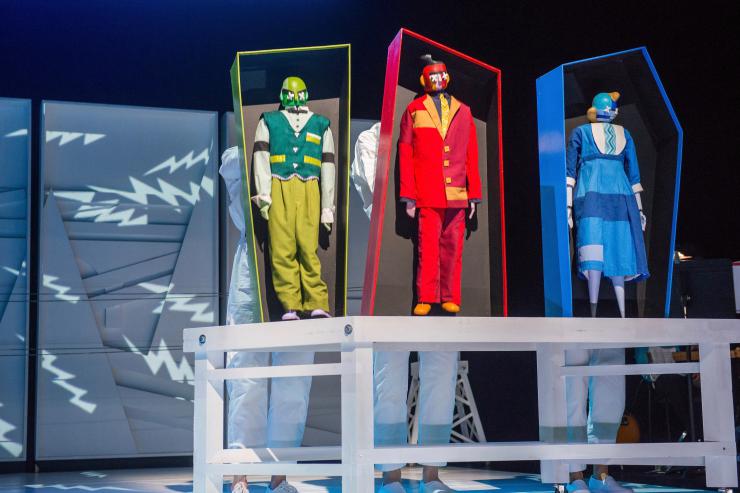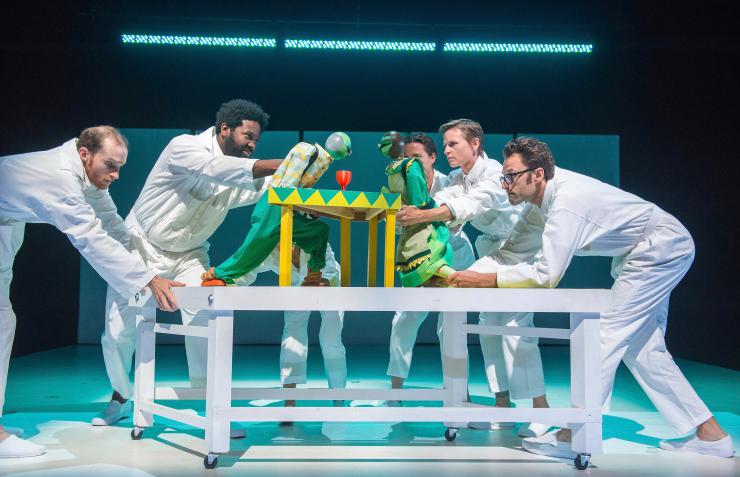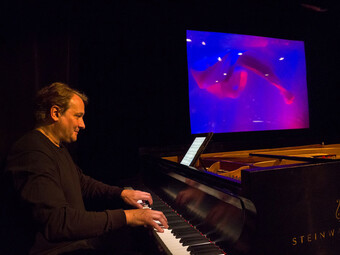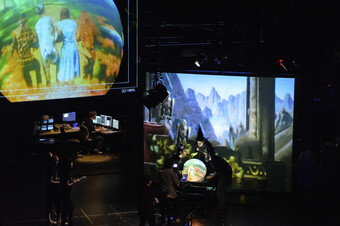The Brutal Made Beautiful
Demolishing Everything with Amazing Speed
This summer, the world has suffered a deluge of violence, and videos of murder and terrorism have flooded social media. Usually shot on cell phones, these clips, such as the killing of Alton Sterling, often share certain stylistic similarities. Slightly blurry, the figures move in bursts of brute mechanical force. Two men tackle another and yell at him, their voices more pneumatic propulsion than speech act. And then, suddenly, the horror. The next day, another, different but always with bodies hurling until they lose locomotion.
Demolishing Everything with Amazing Speed shares many of these stylistic qualities, an incredible feat given that the primary storytelling medium is puppetry. Like the figures in grainy cell phone videos, the puppets are all action. The characters’ psychology is inscrutable, although at times primal human emotions—fear, anger, jealousy, pain—can be read. There is no dialogue, just an actor who narrates stage directions as if reporting the news.
Ultimately, Hurlin and his collaborators’ virtuosity lends a degree of solemnity to the rapid-fire destruction of Depero’s universe that dignifies the moments of mass destruction.
Then there are the gruesome events themselves, some of which uncannily resemble recent headlines. Among limb-tearing and eye-gouging, a figure called the Count kills a cyclist in a uniform (a cop?), steals his gun, and turns into a sniper, shooting up a funeral service before unleashing mayhem at a circus. In Demolishing Everything, puppet master Dan Hurlin has created one of the most relevant productions of the year, an astonishing achievement given that the four plays he and his collaborators have staged were written almost a century ago by the Italian Futurist Fortunato Depero (1892-1960).

Violence and machines fascinated Depero. In Demolishing Everything, characters destroy their surroundings and each other. They commit grand larceny, suicide, and murder. Trains crash and bridges collapse. Action erupts more than it unfolds. In Electric Adventure, one of the four playlets in Demolishing Everything, an epileptic woman abruptly kills a child after returning a bow from her paramour, who is a compulsive bower.
Even at its most brutal, Demolishing Everything with Amazing Speed is eerily beautiful to behold. The dexterity with which Hurlin’s creative team and puppeteers bring the puppets to life does just that. The puppets’ faces, each with its own geometry and color palette, sit atop roughly three-foot tall bodies costumed in rich colors. Executed impeccably by the puppeteers, the puppets move, sometimes fluidly sometimes forcefully, through sets composed of slanted walls, spiral staircases, and floating abstract shapes bathed in saturated hues.
This beauty does not merely decorate. In contrast to Depero’s original vision, Hurlin’s style completely reshapes the audience’s relationship to the action. While Hurlin borrows heavily from the Futurist aesthetic, the politics of Demolishing Everything differ greatly from the political ideology that informed Depero’s art.
Futurism began in 1909, when Filippo Tommaso Marinetti published “The Founding and Manifesto of Futurism.” At the dawn of the twentieth century, Italy’s cultural landscape consisted mainly of Roman ruins and Renaissance art. Marinetti wanted to raze it to the ground. He called for the burning of libraries and museums. Futurism, he believed, would put Italy back at the center of European art and culture.
The Futurists craved action, both human and mechanical, and often fused the two. “We declare that the world's wonder has been enriched by a fresh beauty: the beauty of speed,” wrote Marinetti. Futurist painters and sculptors captured the movements of workers, accelerating trains, and ascending skyscrapers. Futurism’s assault left no medium unscathed. They created poems out of pure noise, releasing words from the bondage of grammar. They invented new instruments, intonarumori, that mimicked motors and other machines.
While the Italian Futurists’ artistic contributions have been heralded widely, their politics make their legacy problematic. From the outset, they praised war and misogyny. The ninth bullet of the first manifesto declares: “We want to glorify war—the only hygiene of the world—militarism, patriotism, the anarchist's destructive gesture, the fine Ideas that kill, and the scorn of woman.” Any contemporary encounter with Futurism must wrestle with their proto-Fascist politics.
Such encounters have increased since 2009, the movement’s centennial. In the last seventy years, art museums have devoted numerous exhibitions to Futurism and its major figures. Most notably, in 2014, the Guggenheim Museum in New York staged Italian Futurism, 1909–1944: Reconstructing the Universe, a massive exhibition that showcased not only the movement’s prolific works of visual art, but also its contributions to music, poetry, publishing, and theatre. Demolishing Everything, which premiered at Bard’s SummerScape Festival, marks a notable event in this resurgence, especially in the theatre.

Depero’s work for the stage was a small part of his artistic output. A painter, playwright, poet, architect, and graphic designer, he arrived in Rome in 1913 and quickly fell in with the Futurists. In 1915, Depero began dreaming and designing machine-like puppets that would liberate theatre and dance from the limitations of the human actor. In April 1918, he and his collaborator Gilbert Clavel, a Swiss poet and Egyptologist, premiered The Plastic Dances (I Balli Plastici), a piece for marionette-style puppets. As a precursor to The Plastic Dances, Depero wrote four puppet plays under the umbrella title Futurist Plastic Dramas (Dramma Plastico Futurista) in 1917 that evaporated into history, having never been produced, until Hurlin discovered them.
An artistic polymath, Hurlin is best known as a creator of works that feature Bunraku-style puppets that he designs and makes. In 2013, while in Rome, he tracked down the scripts and drawings for Futurist Plastic Dramas, and set to work translating, designing, and directing the plays.
Depero’s plays are tragicomedies, and Hurlin’s puppets play them well. The late American critic Daniel Gerould defined the genre, saying, “It combines and somehow fuses the mutually opposed patterns and responses of tragedy and comedy…. The tragic impasse is avoided, but the carefree release of comedy is denied.” Like other tragicomedies—The Tempest or Ionesco’s Exit the King, for example—Depero riddles his plays with the strange and surreal. For example, a baby smoking a huge cigar appears in the belly of a man after he and his wife have mortally wounded each other.
The challenge with Depero’s tragicomedies is that time has amplified the tragedy of their contents—including mass murder and domestic violence—and muted much of the comic.
The challenge with Depero’s tragicomedies is that time has amplified the tragedy of their contents—including mass murder and domestic violence—and muted much of the comic.
To overcome this dramaturgical impasse, Hurlin embraces Depero’s visual and scenic aesthetic while sidestepping the Futurist vision of a synthetic theatre. As Marinetti and several collaborators wrote in a 1915 manifesto: “Our Futurist Theatre will be: Synthetic. That is, very brief. To compress into a few minutes, into a few words and gestures, innumerable situations, sensibilities, ideas, sensations, facts, and symbols.” Depero wanted to immerse the spectator in the action. In contrast, Hurlin enables the audience to hold the violence that pathologically permeates the world of Demolishing Everything at a distance.

One of the ways that Hurling achieves this is through a series of Brechtian techniques: scene titles, narrated stage directions, media (one of the plays, Automatic Thief is essentially a live film on stage), a sleek all-white set and all-white costumes for the puppeteers, and onstage musicians, who play a score of original music by Dan Moses Schreier that combines electronic ambience and rock tones with the Futurists’ love of mechanical noise and irregular rhythms.
One thing in particular that Hurlin compels the audience to think about is World War I. It is difficult to say what Depero thought about the war. In “A Futurist Reconstruction of the Universe,” a manifesto Depero co-wrote with Giacomo Balla, they call World War I, a “marvelous little human conflagration,” compared to the truly global war they envision will be fought with their yet-to-be-built Metallic Animals. Depero never renounced his and his colleagues’ bellicosity during the war, but his scripts do not call the audience to take up arms either.
Hurlin offers a more critical lens with which to view Depero’s historical background by bringing the war to the foreground. The prologue and epilogue of Demolishing Everything is a tiny piece, broken into two, titled Safe. In the epilogue, there are “houses that move themselves, steeples that rise…windows and doors that open and close.” Projection design Tom Lee fills the screen with a montage of World War I and atomic bomb tests. And then, in the final sequence, the landscape erupts in flowers, a gesture that stands somewhere between the sublime and the absurd. It’s an extraordinary tragicomic reversal—billowing bombs to blooming buds—set on a vast, figurative landscape that covers the globe and stretches across decades of war and devastation, touching our own time and place.
The epilogue captures a productive tension that undergirds Demolishing Everything. Throughout, the audience watches two events play out. While the puppets rip each other to pieces, the diverse group of artists brings them to life exquisitely. Ultimately, Hurlin and his collaborators’ virtuosity lends a degree of solemnity to the rapid-fire destruction of Depero’s universe that dignifies the moments of mass destruction.
Hurlin’s dramaturgy is an act of grace toward his predecessor, redeeming some of the unsavory politics of his source material and offering it instead as an occasion for reflection. It is also a gift to audiences, a rare opportunity to see the violence that surrounds us rendered into a beautiful, new creation that portends the possibility that we might still work together—whether in the theatre or in the streets—to overcome that which threatens to tear us apart.







Comments
The article is just the start of the conversation—we want to know what you think about this subject, too! HowlRound is a space for knowledge-sharing, and we welcome spirited, thoughtful, and on-topic dialogue. Find our full comments policy here